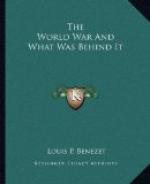The Poles, a divided nation.—The three partitions.—Wars and revolts as a result.—The disappearance of Lithuania.—The growing power of the king of France.—An extravagant and corrupt court.—Peasants cruelly taxed and oppressed.—Bankruptcy at last.—The meeting of the three estates.—The third estate defies the king.—The fall of the Bastille.—The flight and capture of the king.—The king beheaded.—Other kings alarmed.—Valmy saves the revolution.—The reign of terror.
In the flat country to the northeast of Austria-Hungary and east of Prussia lay the kingdom of Poland, the largest country in Europe with the exception of Russia. The Poles, as has been said before, were a Slavic people, distant cousins of the Russians and Bohemians. They had a strong nobility or upper class, but these nobles were jealous of each other, and as a result, the country was torn apart by many warring factions. The condition of the working class was very miserable. The nobles did not allow them any privileges. They were serfs, that is to say, practically slaves, who had to give up to their masters the greater part of the crops that they raised. In the council of the Polish nobles, no law could be passed if a single nobleman opposed it. As a result of this jealousy between factions, the Poles could not be induced to obey any one leader, and thus, divided, were easy to conquer.
Frederick the Great, regretting the fact that he was separated from his land in East Prussia by the county of West Prussia, which was part of Poland, proposed to his old enemy, Maria Theresa of Austria, and to the Empress Catharine II of Russia that they each take a slice of Poland. This was accordingly done, in the year 1772. Poor Poland was unable to resist the three great powers around her, and the other kings of Europe, who had been greedily annexing land wherever they could get it, stood by without a protest. Some twenty years later, Prussia and Russia each again annexed a large part of the remainder of Poland, and two years after this, the three powers divided up among them all that was left of the unhappy kingdom. The Poles fought violently against this last partition, but they were not united and were greatly outnumbered by the troops of the three powers.
This great crime against a nation was the result of the military system; and this in turn was the result of the feudal system, which made the king, as commander-in-chief of the army, the supreme ruler of his country. The men in the Prussian and Austrian armies had no desire to fight and conquer the poor Poles. Victory meant nothing to them. They gained no advantage from it. To the kings who divided up the countries it simply meant an enlargement of their kingdoms, more people to pay taxes to them, and more men to draw on for their armies.
[Illustration: Catharine II]
Instead of crushing out the love of the Poles for their country, this wrongful tearing apart has made their national spirit all the stronger. There have been revolts and bloody wars, caused by Polish uprisings, time and time again, and the Poles will never be satisfied until their unhappy country is once more united.




